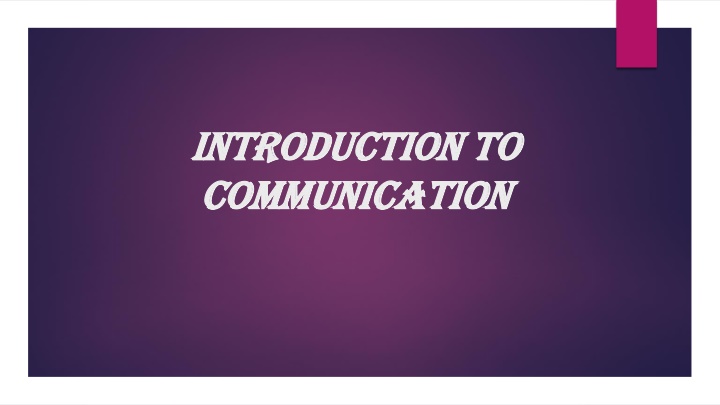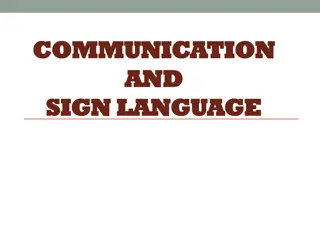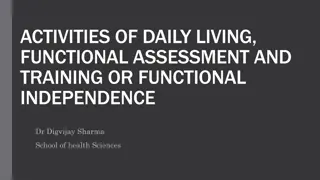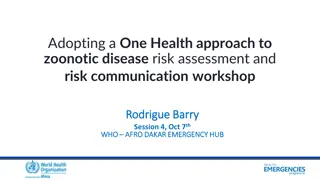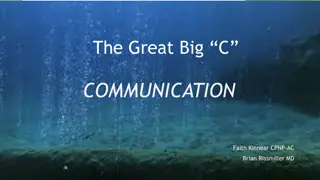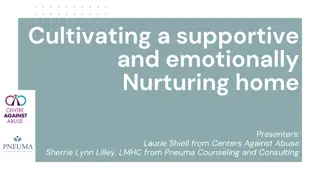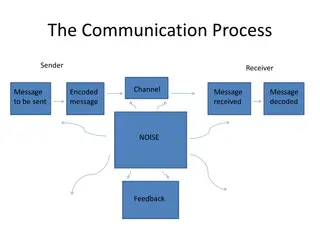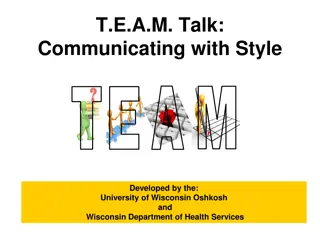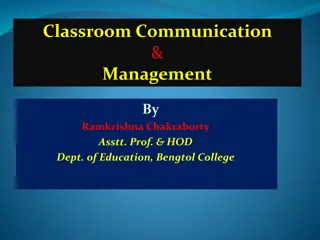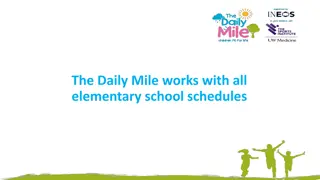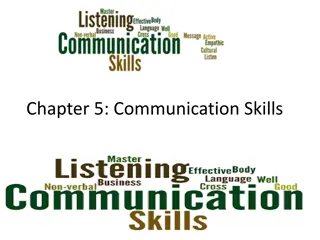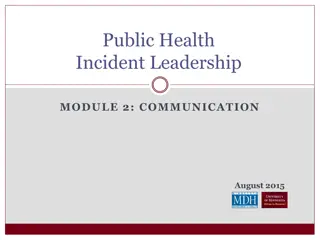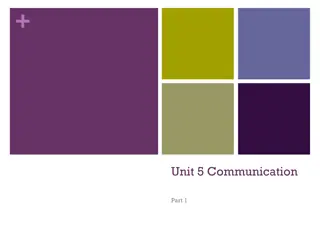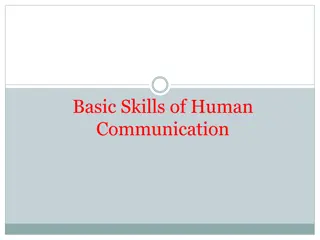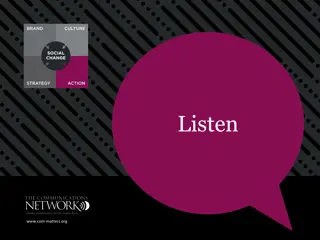Effective Communication Strategies for Daily Life
Communication is the key to sharing thoughts, emotions, and information effectively. Explore the process, goals, types, and barriers of communication. Learn the role of nurses in therapeutic communication and enhance your communication skills for better interactions.
Download Presentation

Please find below an Image/Link to download the presentation.
The content on the website is provided AS IS for your information and personal use only. It may not be sold, licensed, or shared on other websites without obtaining consent from the author.If you encounter any issues during the download, it is possible that the publisher has removed the file from their server.
You are allowed to download the files provided on this website for personal or commercial use, subject to the condition that they are used lawfully. All files are the property of their respective owners.
The content on the website is provided AS IS for your information and personal use only. It may not be sold, licensed, or shared on other websites without obtaining consent from the author.
E N D
Presentation Transcript
Introduction to Introduction to communication communication
Under Supervision Dr : :A Elmassih N Jacoup Dr A Elmassih N Jacoup 2019-2020
General Objectives:- At the end of this lecture we will be able to use the communication effectively in daily life . SPECIFIC OBJECTIVES - : DEFINE COMMUNICATION. DISCUSS COMMUNICATION PROCESS . KNOW GOALS OF COMMUNICATION . MENTION TYPES OF COMMUNICATION . IDENTIFY MOST COMMON WAYS OF COMMUNICATION . MENTION CHARACTERISTICS OF EFFECTIVE COMMUNICATIONS . DISCUSS BARRIERS OF COMMUNICATION . LIST KEY CHARACTERISTICS FOR THE NURSE IN THE THERAPEUTIC COMMUNICATION. ROLE OF NURSE FOR PRACTICE EFFECTIVE THERAPEUTIC COMMUNICATION.
Outlines:- Introduction of communication. Definition of communication. Communication process. Goals of communication . Types of communication . Most common ways of communication . Characteristics of effective communications . Barriers of communication . key characteristics for the nurse in the therapeutic communication. Role of nurse for practice effective therapeutic communication .
Introduction: Communication is the effective sharing or transmission of facts, opinions or emotions by two or more people. It's nearly impossible to go through a day without the use of communication. Communication is sending and receiving information between two or more people. The person sending the message is referred to as the sender, while the person receiving the information is called the receiver. The information conveyed can include facts, ideas, concepts, opinions, beliefs, attitudes, instructions and even emotions.
Definitions:- Communication is a process by which information, ideas, thoughts, feelings and emotions are exchanged between individuals through a common system of symbols, signs, or behavior. Communication is Two-way process of reaching mutual understanding, in which participants not only exchange (encode-decode) information, news, ideas and feelings but also create and share meaning
Communication process:- The process of communication refers to the transmission or passage of information or message from the sender through a selected channel to the receiver overcoming barriers that affect its pace.
1.Sender: The sender is the initiator of the message that need to be transmitted. and has conceptualized the idea that he intends to convey it to others. 2.Encoding: is putting the targeted message into appropriate medium which may be verbal or non-verbal depending upon the situation, time, space and nature of the message to be sent 3.Message: is the heart of communication. It is the content the sender wants to covey to the receiver. It can be verbal both written and spoken; or non-verbal 4.Channel: refers to the way or mode the message flows or is transmitted through. 5. Receiver: The receiver is the person for whom the message is intended or targeted. 6.Decoding: refers to interpreting or converting the sent message into intelligible language. The receiver after receiving the message interprets it and tries to understand it in the best possible manner
7.Feedback: The Feedback is the final step of the process that ensures the receiver has received the message and interpreted it correctly as it was intended by the sender. Types of feedback:- Positive feedback:- -when the message sent by sender has been correctly interpreted by receiver . Negative feedback : - - When the message not understood or poorly transmitted.
Based on communication channel a. Verbal communication is the use of language to transfer information through speaking or sign language. It is one of the most common types, often used during presentations, video conferences and phone calls, meetings and one-on-one conversations.
Verbal Communication is divided into 1 - Oral Communication. 2 - Written Communication. 1-Oral communication:- -In oral communication, Spoken words are used. -It includes face -to- face conversations, speech, telephonic conversation, video, radio, television, voice over Internet. - Communication is influence by volume, speed and clarity of speaking. Advantages:- It brings quick feedback. Disadvantages:- In face-to-face discussion, user is unable to deeply think about what he is delivering, so this can be counted as a fault.
2-Written communication:- In written communication, written signs or symbols are used to communicate. In written communication message can be transmitted via email, letter, report etc Written Communication is most common form of communication being used in business Advantages:- Messages can be edited and revised. Written communication provide record and backup Understand it and send appropriate feedback Disadvantages:- Written communication doesn t bring instant feedback. It takes more time in composing a written message as compared to word-of-mouth and number of people struggles for writing ability.
B-Nonverbal communication:- - The most important part of communication is hearing what isn t said. Peter Drucker -Although verbal communication is important, spoken words make up only a small part of communication. The majority of communication is nonverbal. -Nonverbal communication is made up primarily of facial expressions and body language.
Techniques of Effective nonverbal communication:- - Personal appearance :- One s personal appearance is the combination of one s physical characteristics, style of dress, hygiene, etc. it is a mixture that creates an impression. - Body language :- The sending and receiving of non- verbal message through the use of bodily movements and facial expressions is referred to as body language. These messages sometimes have a greater impact on communication than the verbal messages. - Distance :- The closer the distance between people. That effect communication. - Attending behavior :- These are a combination of behaviors that indicate if and how the receiver is listening to the speaker. They include eye contact.
Characteristics of effective communications:- Effective communication requires the message to be: Clear and concise. Accurate Relevent to the needs of the receiver Timely Meaningful Applicable to the situation
Techniques that enhance communication : -
Using silence Gives the person time to collect thoughts or to think through a point E.g. encouraging a person to talk by waiting for the answers . 1 - : -
Accepting Indicates that the person has been understood. The statement does not necessarily indicate agreement but is nonjudgmental. However, nurses do not imply they understand when they do not understand . e.g. Yes Uh-huh I follow what you say . 2 - : -
Giving Recognition Indicates awareness of change and personal efforts. Does not imply good or bad, or right or wrong.E.g. Good morning, Mr. James. Youve combed your hair today or I notice that you shaved today . 3 - : -
Offering self Offers presence, interest, and a desire to understand. Is not offered to get the person to talk or behave in a specific way.E.g. I would like to spend time with you. Ill stay here and sit with you a while . 4 - : -
5 - Making observations The nurse calls attention to the persons behavior, e.g., trembling biting nails, restless mannerisms. Encourages the person to notice the behavior in order to describe thoughts and feelings for mutual understanding . E.g. You appear tense I notice youre biting your lips. You appear nervous whenever Mr. X enters the roo : -
Encouraging description of perception : - Increases the nurse understands of the patients perceptions. Talking about feelings and difficulties can lessen the need to act them out inappropriately . E.g. what do these voices seem to be saying?" What is happening now ? Tell me when you feel anxious . 6 -
Giving information Makes an available fact the person needs. Supplies knowledge from which decisions can be made or conclusions drawn . E.g. this medication is for 7- :
Presenting Reality Indicates what is real. The nurse does not argue or try to convince the patient. Just describes personal perceptions or facts in the situation . E.g. Your mother is not her 8 - :
Voicing Doubt Undermines the patient beliefs by not reinforcing the exaggerated or false perceptions. E.g. Isnt that unusual ? " 9 - :
- Emphasizes working with the patient, not doing things for the patient. Encourages the view that change is possible through collaboration . E.g. perhaps you and I can discover what produces your anxiety " ''
Effective communication requires the sender to be: Know the subject well Be interested in the subject Speak at the level of the receiver Choose an appropriate communication channel
Effective communication requires the channel to be: Appropriate Affordable Appealing Effective communication requires the receiver to be: Be aware,interested and willing to accept the message Listen attentively understand the value of the message .Provide feedback
Parriers of communication: Psychological barriers:- -Poor pronunciation. - Confused thinking. - Communication overload. - Fear and anxiety. - Suspicious, jealousy, anger. -Resentment, antagonism and prejudices. -Lack of interest and lack of listening. Physical Barriers:- - Physical health. - Poor hearing. - Distance Perceptional barriers:- -Lack of common experience. - Different languages and vocabulary. - Lack of knowledge of any language. - Low IQ. - From receiver s side: interrupting the speaker; asking too many questions. - From sender s side: unclear messages; incomplete sentences, no clarification.
Role of nurse for practice effective therapeutic communication The nurse who is using therapeutic communication will:- - Put the client at ease and develop rapport. - Provide privacy - Respect the client s rights. - Respect the client s personal space. - Try to be at eye level with the client. - Use appropriate eye contact. - Be a good listener - Keep information confidential, as appropriate. - Begin the interview with general information and ask emotionally difficult questions after the client gains confidence and trust. - Adjust language level, as appropriate, for the client. - Not use complex medical terms . - Ask an interpreter to assist, if the client speaks a language different from that of the staff or is hearing impaired.
- Establish a communication system to be used if the client cannot speak or hear or if the client speaks a different language than the nurse. - Be attentive, and concentrate on what the person says. - Try not to write or use a computer during the interview. Pay close attention. Clarify details with the client later. - Show interest in the client s responses. - Ask the client about his or her perceptions. - Pay attention to the client s choice of words any repetition; variations in tone of voice; silence; body language; repetitive behaviors; anxiety; and specific movements, such as tics or unusual speech patterns. - Be careful in touching the client; assess the client s attitudes or ask about touch before using that technique. - Include the family in conversations, if the client prefers.
